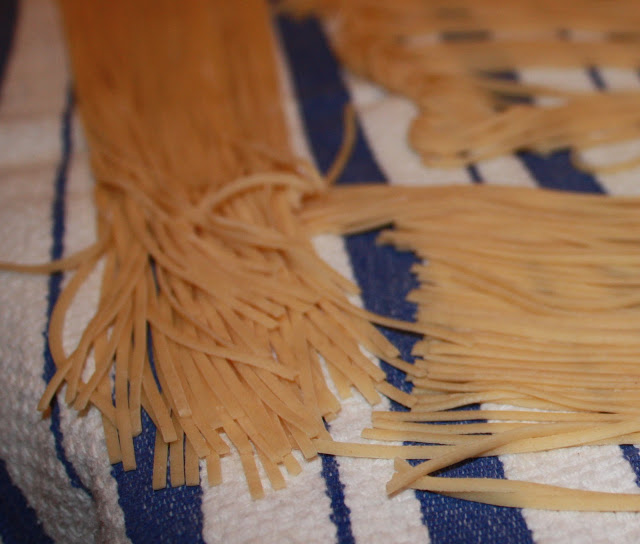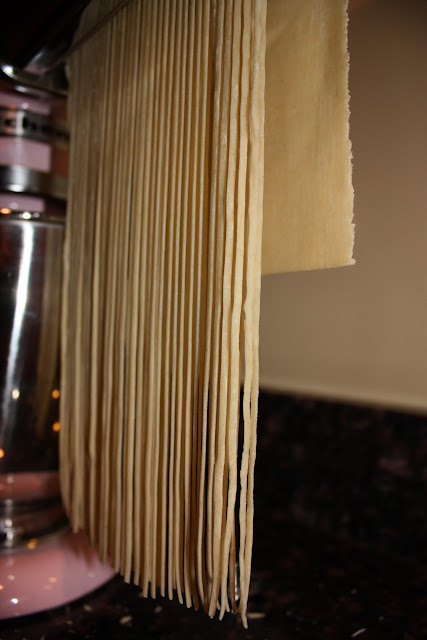Start by sifting three and a half cups of all purpose flour.
Crack four extra-large eggs in the bowl of your kitchenaid. Add one tsp. salt (use table salt, not kosher, for the finer grain). Finish with 1-2 tablespoons of water. Depending on the weather you may need more water. You can tell by the consistency of the dough once you begin mixing. Start with one tbs. and add more if the dough seems too dry. You’re looking for a leathery, pliable consistency.
Add the flour to the bowl. Mix on level two for 30 seconds, using the flat paddle attachment. After 30 seconds, check to see if you need more water and switch to the dough hook. Mix on level two for two minutes. You’re dough should look crumbly but stick together when you press it between your fingers.
Put a little flour on the counter and dump the dough out. Hand knead for two minutes. There will be crumbly bits that don’t stick. That’s ok. You will still have plenty of dough. Roll the dough into a ball and cover completely with saran wrap. Let sit for 20 minutes.
Cut the dough into four pieces. Take one section and recover the remaining dough. Work the section of dough in your hand to flatten it so it can fit through the roller on the first setting.
Work the dough through the roller. It won’t be perfect the first time through. I typically have jagged edges and holes. It will probably look something like the picture below.
Fold the dough in half and press it into itself. Send it back through the roller. Fold again if there are still holes.
Continue to work the dough through the roller on the first setting until the consistency is smooth. Increase the settings, rolling the dough through once or twice, working up to the fifth setting for spaghetti.
Lay the pasta out and cut it in half, trimming the ends so they are even. Set it aside and continue with the remaining three pieces of dough.
I lay my cut sheets side by side on saran wrap. I top each layer with another sheet of saran wrap and then add the next set of pasta sheets. They need to remain covered so the dough won’t dry out.
Now for the fun part! Change out the roller attachment for the spaghetti cutter. Place the pasta sheets through and tada! Spaghetti!
If you are using the pasta right away then just lay it out and place it in salted boiling water. It won’t need any more than two-three minutes. Super fast. You can also dry the pasta by separating the strands and setting them on dishtowels. Let it sit out no more than one hour. Then transfer to an airtight container and store in the refrigerator. This is such an easy thing to do for a dinner party. Just make the pasta the night before or early the day of your party. Dried pasta will cook for two-three minutes longer than fresh pasta. Be careful and test the pasta. You would hate for your hard work to become a soggy mess!
For the sauce, I did what I like to call an ‘everything but the kitchen sink’ sauce. Basically, when we are running low on supplies, I grab whatever veggies need to be used before they turn, a can of diced tomatoes and some spices. Mix, simmer and taste for seasonings. The star of this is the pasta though. It just makes me feel good about myself. I hope it makes you feel good too.
Continue reading for the ingredient list and step-by-step directions!
Makes Four Main Course Servings or Six-Eight Fist Course Servings
- three and a half cups all purpose flour, sifted
- four extra large eggs
- one tsp salt (fine grain, not kosher)
- one to two tbs water
Switch to the dough hook attachment and continue to mix on level two for two minutes. You’re dough should look crumbly but stick together when you press it between your fingers.
Put a little flour on the counter and dump the dough out. Hand knead for two minutes. There will be crumbly bits that don’t stick. That’s ok. You will still have plenty of dough. Roll the dough into a ball and cover completely with saran wrap. Let sit for 20 minutes.
Cut the dough into four pieces. Take one section and recover the remaining dough. Work the section of dough in your hand to flatten it so it can fit through the roller on the first setting.
Work the dough through the roller. It won’t be perfect the first time through. I typically have jagged edges and holes. Fold the dough in half and press it into itself. Send it back through the roller. Fold again if there are still holes.
Continue to work the dough through the roller on the first setting until the consistency is smooth. Increase the settings, rolling the dough through once or twice, working up to the fifth setting for spaghetti.
Lay the pasta out and cut it in half, trimming the ends so they are even. Set it aside, covered so it won’t dry out, and continue with the remaining three pieces of dough.
Once all of the dough has been rolled, change out the roller attachment for the spaghetti cutter. Place the pasta sheets through, creating the spaghetti strands.
If you are using the pasta right away then just lay it out and place it in salted boiling water. It won’t need any more than two-three minutes. You can also freeze the pasta for later use. Form the strands into little nests, dust with flour, and store in a single layer in an air-tight container (see photo below). Frozen pasta will cook for two-three minutes longer than fresh pasta.



Comments 1
That makes me feel good just to look at! Yum and yum.